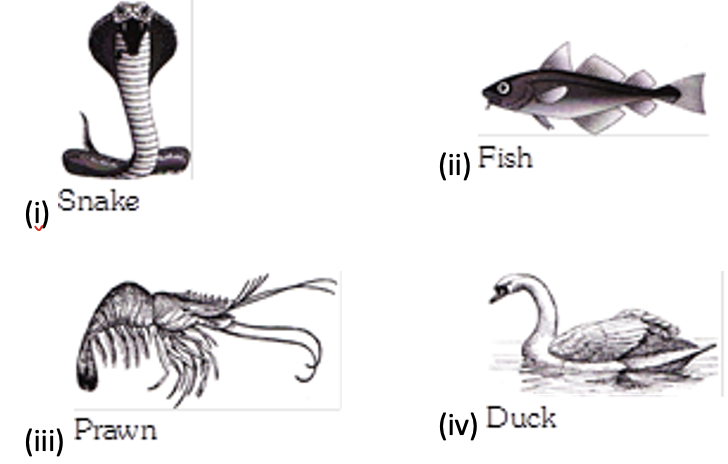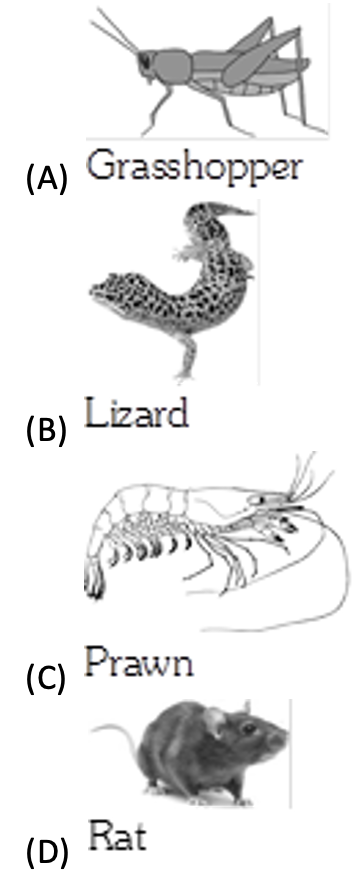CBSE Class 5 EVS Chapter Animals Worksheet Questions and Answers
Q.1 Which of these is an herbivore
(A) Cat
(B) Horse
(C) Dog
(D) Wolf
Answer:
(B)
Q.2 Which animal has the longest sleep hour
(A) Cow
(B) Horse
(C) Sloth
(D) Cat
Answer:
(C)
Q.3 Which animal(s) is/are protected in India through National projects
(A) Lion
(B) Tigers
(C) Elephants
(D) All of these
Answer:
(D)
Q.4 Who discovered the malaria parasite
(A) Ronald Ross
(B) Jenner
(C) Pasteur
(D) J.C. Bose
Answer:
(A)
Q.5 Malaria is spread by which mosquito
(A) Aedes
(B) Anopheles
(C) Culex
(D) None of these
Answer:
(B)
Q.6 Fishes, tadpoles, prawns breath through their......
(A) Lungs
(B) Gills
(C) Spiracles
(D) Nostrils
Answer:
(B)
Q.7 A baby 'X' breathes through its gills. An adult 'X? breathes through its lung on land. What is X?
(A) Whale
(B) Crocodile
(C) Fish
(D) Frog
Answer:
(D)
Q.8 What do the birds do when they see some enemy?
(A) Keep silence
(B) Start chirping all together
(C) Attack on enemies
(D) None of these
Answer:
(B)
Q.9 Animal 'X' eats plant parts. It gives birth to young ones and feeds them with milk. Identify the animal 'X'
(A) Fox
(B) Goat
(C) Tiger
(D) Lion
Answer:
(B)
Q.10 Which one of the following adaptation is not found in fishes?
(A) Air bladder to float on the surface of water
(B) Fins to swim and maintain balance in water.
(C) Wading limbs to swim and wade
(D) Streamlined body
Answer:
(C)
Q.11 Which of the following animals breathe through gills?

(A) (iv) only
(B) Only (i) and (iii)
(C) Only (ii) and (iii)
(D) Only (i), (ii) and (iii)
Answer:
(C)
Q.12 Which of the following statements is / are correct?
(i) Arctic tern travels from Antarctic to Arctic in winter.
(ii) Monarch butterflies travel from Canada to Mexico during the winter season.
(iii) Salmons swim long distances to reach sea to lay eggs.
(iv) Siberian cranes come to India during winter.
(A) (ii) and (iii)
(B) (ii) and (iv)
(C) (i) and (iii)
(D) (i) and (ii)
Answer:
(B)
Q.13 The surroundings in which an animal lives and grows is called its
(A) Climate
(B) Habitat
(C) Behavior
(D) None of these
Answer:
(B)
Q.14 The wings of the birds are their
(A) Hind limbs
(B) Fore limbs
(C) Separate structure
(D) None of these
Answer
(B)
Q.15 Some animals such as snails, turtles and tortoises have.............to protects their soft bodies.
(A) scales
(B) shell
(C) feathers
(D) fur
Answer
(B)
Q.16 Which one of the following reptiles come on to land to lay their eggs and bury the eggs in a hole in a sandy beach?
(A) Snake
(B) Dragon lizard
(C) Penguins
(D) Sea turtle
Answer
(D)
Q.17 The long winter sleep is called
(A) Nap
(B) Hibernation
(C) Nocturnal
(D) None of these
Answer
(A)
Q.18 Which of the following is the purpose of migration in animals?
(A) To escape from harsh weather
(B) To search food
(C) To reach their breeding grounds
(D) All of these
Answer
(D)>
Q.19 Animals use their sense of smell to
(A) Locate food
(B) Find their male/female partner
(C) Detect the presence of their enemies
(D) All of these
Answer
(D)
Q.20 Animals such as the lion, wolf, frog, eagle eat other animals. They are called.
(A) herbivores
(B) omnivores
(C) scavengers
(D) carnivores
Answer:
(A)
Q.21 Bat is odd in the given group of animals because

(A) Is a carnivore
(B) Can fly
(C) Hunts at night
(D) Does not have feathers
Answer:
(D)
Q.22 Animals such as the lion, wolf, frog, eagle eat other animals. They are called.
(A) herbivores
(B) omnivores
(C) scavengers
(D) carnivores
Answer
(D)
Q.23 The earthworm breathes through its....
(A) gills
(B) spiracles
(C) moist skin
(D) lungs
Answer
(C)
Q.24 Camouflage phenomena is seen in which one of the following animals?
(A) Chameleon
(B) Snowy owl
(C) Whale
(D) Polar bear
Answer
(A)
Q.25 Which of the following animals have the strongest sense of smell?
(A) Bats
(B) Cats
(C) Dogs
(D) Monkey
Answer
(C)
Q.26 Features of birds are
I: Their body shapes
II: Smooth waxy feathers
III: Hollow bones
IV: Beaks
Q.27 Which are flight adaptations?
(A) Only I and II
(B) Only III and IV
(C) Only I, II and III
(D) I, II, III and IV
Answer
(C)
Q.28 Poisonous teeth of snakes in called
(A) Feet
(B) Fangs
(C) Fins
(D) None of these
Answer
(B)
Q.29 Which of the following animals breathe through body holes?

Answer
(B)
Q.30 Which of the following is an incorrect statement regarding the given animals?

(A) X is omnivore, Y is herbivores and Z is a carnivore.
(B) X and Y are herbivores, while Z is an omnivore.
(C) X, Y and Z are carnivores
(D) All of these
Answer
(A)
Q.31 Which of the following animals use echolocation?
(A) Bats
(B) Dolphin
(C) Both of these
(D) None of these
Answer
(C)